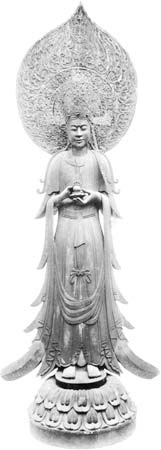Asuka period
Japanese history
in Japanese history and art, era from Ad
 552 to 645 that began with the introduction of Buddhism from Korea and culminated in the adoption of a Chinese pattern of government. Initially opposed by conservative clans, Buddhism found favour with the powerful Soga family which defeated its rivals in a succession dispute in 587. As Imperial regent, Shōtoku Taishi (Shōtoku, Taishi) gave Buddhism official support, and his famous Seventeen Article Constitution, promulgated in 604, outlined moral precepts, largely Buddhist and Confucian in tone, for the establishment of a central government. Although the Soga were destroyed in 645, the reforms carried out from that year until 710 (called the Taika era reforms, q.v.) continued the institution of centralized rule.
552 to 645 that began with the introduction of Buddhism from Korea and culminated in the adoption of a Chinese pattern of government. Initially opposed by conservative clans, Buddhism found favour with the powerful Soga family which defeated its rivals in a succession dispute in 587. As Imperial regent, Shōtoku Taishi (Shōtoku, Taishi) gave Buddhism official support, and his famous Seventeen Article Constitution, promulgated in 604, outlined moral precepts, largely Buddhist and Confucian in tone, for the establishment of a central government. Although the Soga were destroyed in 645, the reforms carried out from that year until 710 (called the Taika era reforms, q.v.) continued the institution of centralized rule.Buddhist art found expression in the temples of the Asuka period, the first major one believed to be the Asuka-dera sponsored by the Soga. Prince Shōtoku founded the Hōryū-ji outside the city of Nara which, though later reconstructed, contains several examples of early Buddhist sculpture.
- Mailer, Norman
- Maillart, Robert
- Maillol, Aristide
- mail-order business
- Mailáth, János, Gróf
- Maiman, Theodore H.
- Maimbourg, Louis
- Maimonides, Moses
- Maimon, Salomon
- Maina
- Main Botanical Garden of the Academy of Sciences
- Main-Danube Canal
- Mai-Ndombe, Lake
- Maine
- Maine de Biran, Marie-François-Pierre
- Maine, destruction of the
- Maine, flag of
- Maine, Louis-Auguste de Bourbon, duc du
- Maine River
- Maine, Sir Henry
- Maine, University of
- Mainichi shimbun
- Mainit, Lake
- Mainland